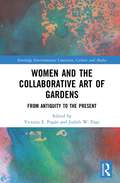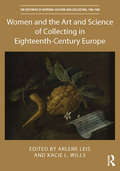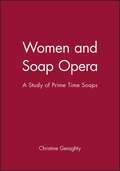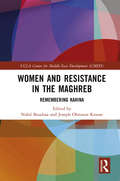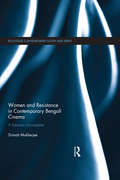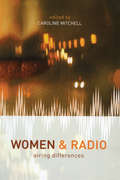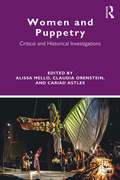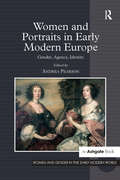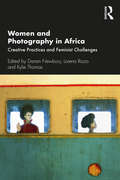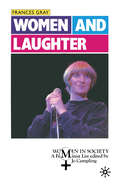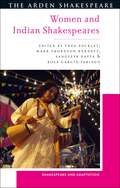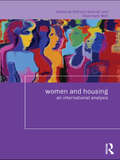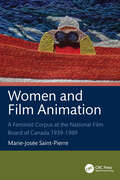- Table View
- List View
Women and the Collaborative Art of Gardens: From Antiquity to the Present (Routledge Environmental Literature, Culture and Media)
by Victoria E. Pagán Judith W. PageWomen and the Collaborative Art of Gardens explores the garden and its agency in the history of the built and natural environments, as evidenced in landscape architecture, literature, art, archaeology, history, photography, and film. Throughout the book, each chapter centers the act of collaboration, from garden clubs of the early twentieth century as powerful models of women’s leadership, to the more intimate partnerships between family members, to the delicate relationship between artist and subject. Women emerge in every chapter, whether as gardeners, designers, owners, writers, illustrators, photographers, filmmakers, or subjects, but the contributors to this dynamic collection unseat common assumptions about the role of women in gardens to make manifest the significant ways in which women write themselves into the accounts of garden design, practice, and history. The book reveals the power of gardens to shape human existence, even as humans shape gardens and their representations in a variety of media, including brilliantly illuminated manuscripts, intricately carved architectural spaces, wall paintings, black and white photographs, and wood cuts. Ultimately, the volume reveals that gardens are best apprehended when understood as products of collaboration. The book will be of interest to scholars and students of gardens and culture, ancient Rome, art history, British literature, medieval France, film studies, women’s studies, photography, African American Studies, and landscape architecture.
Women and the Collaborative Art of Gardens: From Antiquity to the Present (Routledge Environmental Literature, Culture and Media)
Women and the Collaborative Art of Gardens explores the garden and its agency in the history of the built and natural environments, as evidenced in landscape architecture, literature, art, archaeology, history, photography, and film. Throughout the book, each chapter centers the act of collaboration, from garden clubs of the early twentieth century as powerful models of women’s leadership, to the more intimate partnerships between family members, to the delicate relationship between artist and subject. Women emerge in every chapter, whether as gardeners, designers, owners, writers, illustrators, photographers, filmmakers, or subjects, but the contributors to this dynamic collection unseat common assumptions about the role of women in gardens to make manifest the significant ways in which women write themselves into the accounts of garden design, practice, and history. The book reveals the power of gardens to shape human existence, even as humans shape gardens and their representations in a variety of media, including brilliantly illuminated manuscripts, intricately carved architectural spaces, wall paintings, black and white photographs, and wood cuts. Ultimately, the volume reveals that gardens are best apprehended when understood as products of collaboration. The book will be of interest to scholars and students of gardens and culture, ancient Rome, art history, British literature, medieval France, film studies, women’s studies, photography, African American Studies, and landscape architecture.
Women and the Art and Science of Collecting in Eighteenth-Century Europe (The Histories of Material Culture and Collecting, 1700-1950)
by Arlene Leis Kacie L. WillsThrough both longer essays and shorter case studies, this book examines the relationship of European women from various countries and backgrounds to collecting, in order to explore the social practices and material and visual cultures of collecting in eighteenth-century Europe.It recovers their lives and examines their interests, their methodologies, and their collections and objects—some of which have rarely been studied before. The book also considers women’s role as producers, that is, creators of objects that were collected. Detailed examination of the artefacts—both visually, and in relation to their historical contexts—exposes new ways of thinking about collecting in relation to the arts and sciences in eighteenth-century Europe. The book is interdisciplinary in its makeup and brings together scholars from a wide range of fields.It will be of interest to those working in art history, material and visual culture, history of collecting, history of science, literary studies, women’s studies, gender studies, and art conservation.
Women and the Art and Science of Collecting in Eighteenth-Century Europe (The Histories of Material Culture and Collecting, 1700-1950)
by Arlene Leis Kacie L. WillsThrough both longer essays and shorter case studies, this book examines the relationship of European women from various countries and backgrounds to collecting, in order to explore the social practices and material and visual cultures of collecting in eighteenth-century Europe.It recovers their lives and examines their interests, their methodologies, and their collections and objects—some of which have rarely been studied before. The book also considers women’s role as producers, that is, creators of objects that were collected. Detailed examination of the artefacts—both visually, and in relation to their historical contexts—exposes new ways of thinking about collecting in relation to the arts and sciences in eighteenth-century Europe. The book is interdisciplinary in its makeup and brings together scholars from a wide range of fields.It will be of interest to those working in art history, material and visual culture, history of collecting, history of science, literary studies, women’s studies, gender studies, and art conservation.
Women And Soap Opera: A Study Of Prime Time Soaps (Social Psychology And Society Ser.)
by Christine GeraghtyThis is the first major study of the roles of women in prime time soap operas. In a comparative analysis of British and North American television soaps, Christine Geraghty examines the relationship between the narratives on the screen and the women viewers who make up the traditional soap audience. Within the structure of many of the most popular soaps, such as Dallas, Dynasty, Coronation Street and EastEnders, the split between public and personal life, reason and emotion, work and leisure is turned into a lynchpin of the plot. The author argues that these themes are also linked to broader social divisions between men and women, divisions which soap operas both question and develop as a source of pleasure. Geraghty analyses the critical role of women characters in the families and communities of soaps and suggests that the utopian possibilities of soaps can be used not just to maintain the status quo, but to promote change and influence attitudes and prejudices. She examines the way in which soaps have been transformed in the last decade, looking at how issues of class, race, sexual orientation and feminism have been handled in the programmes. She argues that in pursuing new audiences more recent soaps such as Brookside may have put at risk the pleasures they have traditionally offered their women viewers. Women and Soap Opera is a detailed, thoughtful and wide-ranging analysis which will become a central work in women's studies and media and cultural studies courses.
Women and Resistance in the Maghreb: Remembering Kahina (UCLA Center for Middle East Development (CMED))
by Nabil BoudraaThis book studies women’s resistance in the three countries of the Maghreb, concentrating on two questions: First, what has been the role of women artists since the 1960s in unlocking traditions and emancipating women on their own terms? Second, why have Maghrebi women rarely been given the right to be heard since Algeria, Morocco, and Tunisia gained national independence? Honouring the artistic voices of women that have been largely eclipsed from both popular culture and political discourse in the Maghreb, the work specifically examines resistance by women since 1960s in the Maghreb through cinema, politics, and the arts. In an ancillary way, the volume addresses a wide range of questions that are specific to Maghrebi women related to upbringing, sexuality, marriage, education, representation, exclusion, and historical memory. These issues, in their broadest dimensions, opened the gates to responses in different fields in both the humanities and the social sciences. The research presents scholarship by not only leading scholars in Francophone studies, cultural history, and specialists in women studies, but also some of the most important film critics and practicing feminist advocates. The variety of periods and disciplines in this collection allow for a coherent and general understanding of Maghrebi societies since decolonization. The volume is a key resource to students and scholars interested in women’s studies, the Maghreb, and Middle East studies.
Women and Resistance in the Maghreb: Remembering Kahina (UCLA Center for Middle East Development (CMED))
by Nabil Boudraa Joseph Ohmann KrauseThis book studies women’s resistance in the three countries of the Maghreb, concentrating on two questions: First, what has been the role of women artists since the 1960s in unlocking traditions and emancipating women on their own terms? Second, why have Maghrebi women rarely been given the right to be heard since Algeria, Morocco, and Tunisia gained national independence? Honouring the artistic voices of women that have been largely eclipsed from both popular culture and political discourse in the Maghreb, the work specifically examines resistance by women since 1960s in the Maghreb through cinema, politics, and the arts. In an ancillary way, the volume addresses a wide range of questions that are specific to Maghrebi women related to upbringing, sexuality, marriage, education, representation, exclusion, and historical memory. These issues, in their broadest dimensions, opened the gates to responses in different fields in both the humanities and the social sciences. The research presents scholarship by not only leading scholars in Francophone studies, cultural history, and specialists in women studies, but also some of the most important film critics and practicing feminist advocates. The variety of periods and disciplines in this collection allow for a coherent and general understanding of Maghrebi societies since decolonization. The volume is a key resource to students and scholars interested in women’s studies, the Maghreb, and Middle East studies.
Women and Resistance in Contemporary Bengali Cinema: A Freedom Incomplete (Routledge Contemporary South Asia Series)
by Srimati MukherjeeHistorically, Indian cinema has positioned women at the intersection of tradition and a more evolving culture, portraying contradictory attitudes which affect women’s roles in public and private spheres. Examining the work of three directors from West Bengal, this book addresses the juxtaposition of tradition and culture regarding women in Bengali cinema. It argues the antithesis of women’s roles, particularly in terms of ideas of resistance, revolution, change, and autonomy, by suggesting they convey resistance to hegemonic structures, encouraging a re-envisioning of women’s positions within the familial-social matrix. Along with presenting a perception of culture as dynamic and evolving, the book discusses how some directors show that with this rupturing of the traditionally prohibitive, and a notion of unmaking and making in women, a traditional inclination is exposed to align women with ideas of absence, substitution, and disposability. The author goes on to show how selected auteurs in contemporary Bengali cinema break with certain traditional representations of women, gesturing towards a culture that is more liberating for women. Presenting the first full-length study of women’s changing roles over the last twenty years of Bengali cinema, this book will be a useful contribution for students and scholars of South Asian Culture, Film Studies and Gender Studies.
Women and Resistance in Contemporary Bengali Cinema: A Freedom Incomplete (Routledge Contemporary South Asia Series)
by Srimati MukherjeeHistorically, Indian cinema has positioned women at the intersection of tradition and a more evolving culture, portraying contradictory attitudes which affect women’s roles in public and private spheres. Examining the work of three directors from West Bengal, this book addresses the juxtaposition of tradition and culture regarding women in Bengali cinema. It argues the antithesis of women’s roles, particularly in terms of ideas of resistance, revolution, change, and autonomy, by suggesting they convey resistance to hegemonic structures, encouraging a re-envisioning of women’s positions within the familial-social matrix. Along with presenting a perception of culture as dynamic and evolving, the book discusses how some directors show that with this rupturing of the traditionally prohibitive, and a notion of unmaking and making in women, a traditional inclination is exposed to align women with ideas of absence, substitution, and disposability. The author goes on to show how selected auteurs in contemporary Bengali cinema break with certain traditional representations of women, gesturing towards a culture that is more liberating for women. Presenting the first full-length study of women’s changing roles over the last twenty years of Bengali cinema, this book will be a useful contribution for students and scholars of South Asian Culture, Film Studies and Gender Studies.
Women and Radio: Airing Differences
by Caroline MitchellCombining classic work on radio with innovative research, journalism and biography, Women and Radio offers a variety of approaches to understanding the position of women as producers, presenters and consumers as well as offering guidelines, advice and helpful information for women wanting to work in radio.Women and Radio examines the relationship between radio audiences, technologies and programming and reveals and explains the inequalities experienced by women working in the industry.
Women and Radio: Airing Differences
by Caroline MitchellCombining classic work on radio with innovative research, journalism and biography, Women and Radio offers a variety of approaches to understanding the position of women as producers, presenters and consumers as well as offering guidelines, advice and helpful information for women wanting to work in radio.Women and Radio examines the relationship between radio audiences, technologies and programming and reveals and explains the inequalities experienced by women working in the industry.
Women and Puppetry: Critical and Historical Investigations
by Alissa Mello Claudia Orenstein Cariad AstlesWomen and Puppetry is the first publication dedicated to the study of women in the field of puppetry arts. It includes critical articles and personal accounts that interrogate specific historical moments, cultural contexts, and notions of "woman" on and off stage. Part I, "Critical Perspective," includes historical and contemporary analyses of women’s roles in society, gender anxiety revealed through the unmarked puppet body, and sexual expression within oppressive social contexts. Part II, "Local Contexts: Challenges and Transformations," investigates work of female practitioners within specific cultural contexts to illuminate how women are intervening in traditionally male spaces. Each chapter in Part II offers brief accounts of specific social histories, barriers, and gender biases that women have faced, and the opportunities afforded female creative leaders to appropriate, revive, and transform performance traditions. And in Part III, "Women Practitioners Speak," contemporary artists reflect on their experiences as female practitioners within the art of puppet theatre. Representing female writers and practitioners from across the globe, Women and Puppetry offers students and scholars a comprehensive interrogation of the challenges and opportunities that women face in this unique art form.
Women and Puppetry: Critical and Historical Investigations
by Alissa Mello Claudia Orenstein Cariad AstlesWomen and Puppetry is the first publication dedicated to the study of women in the field of puppetry arts. It includes critical articles and personal accounts that interrogate specific historical moments, cultural contexts, and notions of "woman" on and off stage. Part I, "Critical Perspective," includes historical and contemporary analyses of women’s roles in society, gender anxiety revealed through the unmarked puppet body, and sexual expression within oppressive social contexts. Part II, "Local Contexts: Challenges and Transformations," investigates work of female practitioners within specific cultural contexts to illuminate how women are intervening in traditionally male spaces. Each chapter in Part II offers brief accounts of specific social histories, barriers, and gender biases that women have faced, and the opportunities afforded female creative leaders to appropriate, revive, and transform performance traditions. And in Part III, "Women Practitioners Speak," contemporary artists reflect on their experiences as female practitioners within the art of puppet theatre. Representing female writers and practitioners from across the globe, Women and Puppetry offers students and scholars a comprehensive interrogation of the challenges and opportunities that women face in this unique art form.
Women and Portraits in Early Modern Europe: Gender, Agency, Identity (Women and Gender in the Early Modern World)
by Andrea PearsonAs one of the first books to treat portraits of early modern women as a discrete subject, this volume considers the possibilities and limits of agency and identity for women in history and, with particular attention to gender, as categories of analysis for women's images. Its nine original essays on Italy, the Low Countries, Germany, France, and England deepen the usefulness of these analytical tools for portraiture. Among the book's broad contributions: it dispels false assumptions about agency's possibilities and limits, showing how agency can be located outside of conventional understanding, and, conversely, how it can be stretched too far. It demonstrates that agency is compatible with relational gender analysis, especially when alternative agencies such as spectatorship are taken into account. It also makes evident the importance of aesthetics for the study of identity and agency. The individual essays reveal, among other things, how portraits broadened the traditional parameters of portraiture, explored transvestism and same-sex eroticism, appropriated aspects of male portraiture to claim those values for their sitters, and, as sites for gender negotiation, resistance, and debate, invoked considerable relational anxiety. Richly layered in method, the book offers an array of provocative insights into its subject.
Women and Portraits in Early Modern Europe: Gender, Agency, Identity (Women and Gender in the Early Modern World)
by Andrea PearsonAs one of the first books to treat portraits of early modern women as a discrete subject, this volume considers the possibilities and limits of agency and identity for women in history and, with particular attention to gender, as categories of analysis for women's images. Its nine original essays on Italy, the Low Countries, Germany, France, and England deepen the usefulness of these analytical tools for portraiture. Among the book's broad contributions: it dispels false assumptions about agency's possibilities and limits, showing how agency can be located outside of conventional understanding, and, conversely, how it can be stretched too far. It demonstrates that agency is compatible with relational gender analysis, especially when alternative agencies such as spectatorship are taken into account. It also makes evident the importance of aesthetics for the study of identity and agency. The individual essays reveal, among other things, how portraits broadened the traditional parameters of portraiture, explored transvestism and same-sex eroticism, appropriated aspects of male portraiture to claim those values for their sitters, and, as sites for gender negotiation, resistance, and debate, invoked considerable relational anxiety. Richly layered in method, the book offers an array of provocative insights into its subject.
Women and Photography in Africa: Creative Practices and Feminist Challenges
by Darren Newbury; Lorena Rizzo; Kylie ThomasThis collection explores women’s multifaceted historical and contemporary involvement in photography in Africa. The book offers new ways of thinking about the history of photography, exploring through case studies the complex and historically specific articulations of gender and photography on the continent, and attending to the challenge and potential of contemporary feminist and postcolonial engagements with the medium. The volume is organised in thematic sections that present the lives and work of historically significant yet overlooked women photographers, as well as the work of acclaimed contemporary African women photographers such as Héla Ammar, Fatoumata Diabaté, Lebohang Kganye and Zanele Muholi. The book offers critical reflections on the politics of gendered knowledge production and the production of racialised and gendered identities and alternative and subaltern subjectivities. Several chapters illuminate how contemporary African women photographers, collectors and curators are engaging with colonial photographic archives to contest stereotypical forms of representation and produce powerful counter-histories. Raising critical questions about race, gender and the history of photography, the collection provides a model for interdisciplinary feminist approaches for scholars and students of art history, visual studies and African history.
Women and Photography in Africa: Creative Practices and Feminist Challenges
by Darren Newbury Lorena Rizzo Kylie ThomasThis collection explores women’s multifaceted historical and contemporary involvement in photography in Africa. The book offers new ways of thinking about the history of photography, exploring through case studies the complex and historically specific articulations of gender and photography on the continent, and attending to the challenge and potential of contemporary feminist and postcolonial engagements with the medium. The volume is organised in thematic sections that present the lives and work of historically significant yet overlooked women photographers, as well as the work of acclaimed contemporary African women photographers such as Héla Ammar, Fatoumata Diabaté, Lebohang Kganye and Zanele Muholi. The book offers critical reflections on the politics of gendered knowledge production and the production of racialised and gendered identities and alternative and subaltern subjectivities. Several chapters illuminate how contemporary African women photographers, collectors and curators are engaging with colonial photographic archives to contest stereotypical forms of representation and produce powerful counter-histories. Raising critical questions about race, gender and the history of photography, the collection provides a model for interdisciplinary feminist approaches for scholars and students of art history, visual studies and African history.
Women and Migration in Contemporary Italian Cinema: Screening Hospitality (Transnational Italian Cultures #7)
by Giovanna Faleschini LernerWomen and Migration in Contemporary Italian Cinema: Screening Hospitality puts gender at the centre of cinematic representations of contemporary transnational Italian identities. It offers an intersectional feminist analysis of the ways in which transnational migration has been represented, understood, and constructed in the contemporary cinema of Italy. Drawing on Jacques Derrida’s notion of hospitality and in dialogue with postcolonial and decolonial theory, queer studies, and feminist critiques, the six chapters of the book focus on a series of exemplary fiction films from the last twenty years, which both reflect and shape the nation’s responses to the growing presence of transnational migrants in Italian society. The book shows how questions of gender, sexual difference, and reproductivity have been central to Italian filmmakers’ approaches to stories of mobility and displacement. Gender is also enmeshed in the rhetoric and poetic of hospitality that filmmakers propose as a critical framework to condemn Italian border policies and politics. Women and Migration in Contemporary Italian Cinema: Screening Hospitality traces an arc that moves from the embrace of a humanitarian rhetoric of infinite hospitality toward migrants, apparent in films produced in the early 2000s, to a more fluid understanding of Italian identities from a transnational perspective.
Women and Migration: Responses In Art And History
by Deborah Willis Ellyn Toscano Kalia Brooks NelsonThe essays in this book chart how women’s profound and turbulent experiences of migration have been articulated in writing, photography, art and film. As a whole, the volume gives an impression of a wide range of migratory events from women’s perspectives, covering the Caribbean Diaspora, refugees and slavery through the various lenses of politics and war, love and family. The contributors, which include academics and artists, offer both personal and critical points of view on the artistic and historical repositories of these experiences. Selfies, motherhood, violence and Hollywood all feature in this substantial treasure-trove of women’s joy and suffering, disaster and delight, place, memory and identity. This collection appeals to artists and scholars of the humanities, particularly within the social sciences; though there is much to recommend it to creatives seeking inspiration or counsel on the issue of migratory experiences.
Women and Laughter (Women in Society: A Feminist List)
by Frances GrayTraditionally women have no sense of humour. This book explodes the myth by explaining the impact of women on popular comedy as sitcom stars and as standup comics. It also looks at the implications of the myth itself, and its serious consequences for women politically as well as socially.
Women and Indian Shakespeares (Shakespeare and Adaptation)
by Mark Thornton BurnettWomen and Indian Shakespeares explores the multiple ways in which women, and those identifying as women, are, and have been, engaged with Shakespeare in India. Women's engagements encompass the full range of media, from translation to cinematic adaptation and from early colonial performance to contemporary theatrical experiment. Simultaneously, Women and Indian Shakespeares makes visible the ways in which women are figured in various representational registers as resistant agents, martial seductresses, redemptive daughters, victims of caste discrimination, conflicted spaces and global citizens. In so doing, the collection reorients existing lines of investigation, extends the disciplinary field, brings into visibility still occluded subjects and opens up radical readings. More broadly, the collection identifies how, in Indian Shakespeares on page, stage and screen, women increasingly possess the ability to shape alternative futures across patriarchal and societal barriers of race, caste, religion and class. In repeated iterations, the collection turns our attention to localized modes of adaptation that enable opportunities for women while celebrating Shakespeare's gendered interactions in India's rapidly changing, and increasingly globalized, cultural, economic and political environment. In the contributions, we see a transformed Shakespeare, a playwright who appears differently when seen through the gendered eyes of a new Indian, diasporic and global generation of critics, historians, archivists, practitioners and directors. Radically imagining Indian Shakespeares with women at the centre, Women and Indian Shakespeares interweaves history, regional geography/regionality, language and the present day to establish a record of women as creators and adapters of Shakespeare in Indian contexts.
Women and Indian Shakespeares (Shakespeare and Adaptation)
by Mark Thornton BurnettWomen and Indian Shakespeares explores the multiple ways in which women, and those identifying as women, are, and have been, engaged with Shakespeare in India. Women's engagements encompass the full range of media, from translation to cinematic adaptation and from early colonial performance to contemporary theatrical experiment. Simultaneously, Women and Indian Shakespeares makes visible the ways in which women are figured in various representational registers as resistant agents, martial seductresses, redemptive daughters, victims of caste discrimination, conflicted spaces and global citizens. In so doing, the collection reorients existing lines of investigation, extends the disciplinary field, brings into visibility still occluded subjects and opens up radical readings. More broadly, the collection identifies how, in Indian Shakespeares on page, stage and screen, women increasingly possess the ability to shape alternative futures across patriarchal and societal barriers of race, caste, religion and class. In repeated iterations, the collection turns our attention to localized modes of adaptation that enable opportunities for women while celebrating Shakespeare's gendered interactions in India's rapidly changing, and increasingly globalized, cultural, economic and political environment. In the contributions, we see a transformed Shakespeare, a playwright who appears differently when seen through the gendered eyes of a new Indian, diasporic and global generation of critics, historians, archivists, practitioners and directors. Radically imagining Indian Shakespeares with women at the centre, Women and Indian Shakespeares interweaves history, regional geography/regionality, language and the present day to establish a record of women as creators and adapters of Shakespeare in Indian contexts.
Women and Housing: An International Analysis (Housing and Society Series)
by Patricia KennettIn the context of contemporary economic, political, social and cultural transformations, this book brings together contributions from developed and emerging societies in Europe, the USA and East Asia in order to highlight the nature, extent and impact of these changes on the housing opportunities of women. The collection seeks to contribute to comparative housing debates by highlighting the gendered nature of housing processes, locating these processes within wider structured and institutionalized relations of power, and to show how these socially constructed relationships are culturally contingent, and manifest and transform over time and space. The international contributors draw on a wide range of empirical evidence relating to labour market participation, wealth distribution, family formation and education to demonstrate the complexity and gendered nature of the interlocking arenas of production, reproduction and consumption and the implications for the housing opportunities of women in different social contexts. Worldwide examples are drawn from Australia, China, Great Britain, Hong Kong, Japan, Spain, Sweden, Taiwan and the USA.
Women and Housing: An International Analysis (Housing and Society Series)
by Patricia Kennett Kam Wah ChanIn the context of contemporary economic, political, social and cultural transformations, this book brings together contributions from developed and emerging societies in Europe, the USA and East Asia in order to highlight the nature, extent and impact of these changes on the housing opportunities of women. The collection seeks to contribute to comparative housing debates by highlighting the gendered nature of housing processes, locating these processes within wider structured and institutionalized relations of power, and to show how these socially constructed relationships are culturally contingent, and manifest and transform over time and space. The international contributors draw on a wide range of empirical evidence relating to labour market participation, wealth distribution, family formation and education to demonstrate the complexity and gendered nature of the interlocking arenas of production, reproduction and consumption and the implications for the housing opportunities of women in different social contexts. Worldwide examples are drawn from Australia, China, Great Britain, Hong Kong, Japan, Spain, Sweden, Taiwan and the USA.
Women and Film Animation: A Feminist Corpus at the National Film Board of Canada 1939-1989
by Marie-Josée Saint-PierreThe creations of female animation filmmakers are recognized all over the world while being, paradoxically, unknown to the general public. Women and Film Animation: A Feminist Corpus at the National Film Board of Canada 1939-1989 brings out of the shadows the work of true pioneers by presenting and analyzing, from a resolutely feminist perspective, the works they have conceived within the National Film Board of Canada (NFB).This institution has played an essential role in the emergence of animated cinema in Canada, but it is forgotten or ignored that a good part of this vast corpus is the work of women who have worked there not only as assistants but also as directors. These artists have contributed to changing the traditional representations of women in a unique way in both commercial and avant-garde animated cinema. The author accounts for their concerns, their creativity, and their many bright achievements. To do this, she relies on a wide range of critical works in social and cultural history of Canada, in feminist art history, and on multiple studies on animated cinema.Key Features: Provides an interdisciplinary approach that combines concepts from feminist studies, film theory and visual arts for a nuanced analysis of the role of women in animated cinema Discusses historical and sociological background that sheds light on the condition of women Includes a profound analysis of the changes and continuities in the role of women in this industry over time, focusing on the National Film Board of Canada Features previously unreleased archival material and selected excerpts from reviews by the NFB’s programming committee, highlighting the impact of production circumstances of the works of specific women animators
